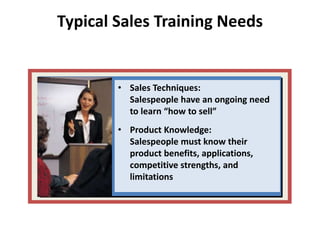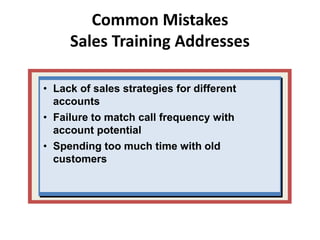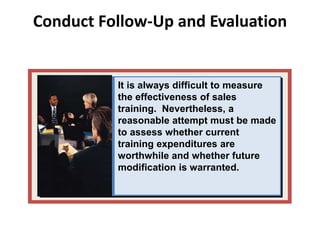09 6e Sales Management module 06
- 1. Continual Development of the Sales Force: Sales Training Module Six
- 2. Role of Sales Training in Sales Force Socialization Sales training helps socialize the new hires, providing them with a positive: • Role Definition — An understanding of what tasks are to be performed, what the priorities of the tasks are, and how time should be allocated among the tasks. • Initiation to Task — The degree to which a sales trainee feels competent and accepts as a working partner
- 3. Sales Training as a Crucial Investment • Most organizations see a link between sales training and salesperson productivity • U.S. companies spend approximately $8.7 billion annually on training • The need for sales training is continual • Sales managers play a crucial role in the training process
- 4. Managing the Sales Training Process Assess Sales Training Needs Set Training Objectives Evaluate Training Alternatives Design Sales Training Program Perform Sales Training Conduct Follow-Up and Evaluation
- 5. Assess Training Needs • Determine desired skill set and levels of performance • Assess salesperson’s actual skill set and levels of performance • Analyze gap between desired and actual to determine training needs
- 6. Assess Training Needs: Methods • Sales Force Audit • Performance Testing • Observation • Salesforce Survey • Customer Survey • Job analysis
- 7. Typical Sales Training Needs • Sales Techniques: Salespeople have an ongoing need to learn “how to sell” • Product Knowledge: Salespeople must know their product benefits, applications, competitive strengths, and limitations
- 8. Typical Sales Training Needs • Customer Knowledge: Salespeople should know their customer needs, buying motives, buying procedures, and personalities. • Competitive Knowledge: Salespeople must know competitive offerings in terms of strengths and weaknesses.
- 9. Typical Sales Training Needs • Time and Territory Management: Salespeople should learn to maximum work efficiency.
- 10. Competencies of Successful Salespeople • Aligning customer/supplier strategic objectives • Listening beyond product needs • Understanding the financial impact of decisions • Orchestrating organizational resources • Consultative problem solving
- 11. • Establishing a vision of a committed customer/supplier relationship • Engaging in self-appraisal and continuous learning Competencies of Successful Salespeople
- 12. Common Mistakes Sales Training Addresses • Ineffective listening and questioning • Failure to build rapport and trust • Poor job of prospecting for new accounts • Lack of preplanning of sales calls • Reluctance to make cold calls (without an appointment)
- 13. • Lack of sales strategies for different accounts • Failure to match call frequency with account potential • Spending too much time with old customers Common Mistakes Sales Training Addresses
- 14. • Over-controlling the sales call • Failure to respond to customers’ needs with benefits • Giving benefits before clarifying customers’ needs • Ineffective handling of negative attitudes • Failure to effectively confirm the sale Common Mistakes Sales Training Addresses
- 15. Training Objectives • Increase sales or profits • Create positive attitudes and improve salesforce morale • Assist in sales force socialization • Reduce role conflict and ambiguity
- 16. Training Objectives • Introduce new products, markets, and promotional programs • Develop salespeople for future management positions • Ensure awareness of ethical and legal responsibilities
- 17. Training Objectives • Teach administrative procedures • Ensure competence in the use of sales and sales support tools • Minimize sales force turnover rate • Prepare new salespeople for assignment to a sales territory • Improve teamwork & cooperative efforts
- 18. Evaluate Training Alternatives • Selecting Sales Trainers – Internal – External • Selecting Sales Training Locations – Decentralized (e.g., district or regional offices) – Centralized (e.g., corporate headquarter)
- 19. Evaluate Training Alternatives • Selecting Sales Training Methods – Classroom/Conference Training – On-the-job Training (OJT) • Mentoring • Job rotation
- 20. Evaluate Training Alternatives • Selecting Sales Training Methods – Behavioral Simulations – Absorption Training • Selecting Sales Training Media – Internet – Computer-Based (e.g., CD-ROM) – Paper-Based
- 21. Design the Sales Training Program • Finalize the Training Program • Schedule Training Sessions • Make Necessary Travel Arrangements • Make Necessary Accommodation Arrangements
- 22. Perform Sales Training As the training is being conducted, the sales manager’s primary responsibility is to monitor progress of the trainees and to ensure adequate presentation of the training topics.
- 23. Conduct Follow-Up and Evaluation It is always difficult to measure the effectiveness of sales training. Nevertheless, a reasonable attempt must be made to assess whether current training expenditures are worthwhile and whether future modification is warranted.






















